Variations in Flowers
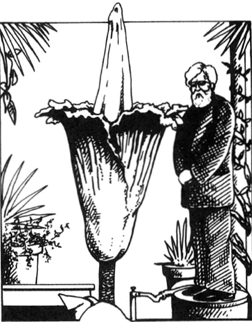 |
| Figure 35-6 Arnorphophallus titanurn, another gigantic flower. This plant grows in Sumatra. |
There is great variation in flowers. Some flowers are so small that they can scarcely be seen without a lens. One examplies duckweed, Lemna minor, an aquatic plant found floating on water. At the opposite extreme is a plant of the Malay peninsula. Raflesia produces flowers measuring three to four feet in diameter. It is called the “stinking corpse lily” and attracts carrion-eating beetles. Another giant flower, called Amorphophallus titanum, is shown in figure 35-6.
Sometimes the calyx or corolla (known as perianth parts) is missing; in this case, the flower is called incomplete. If both stamens and pistil are present, the flower is said to be perfect. If one or the other of these is lacking, the flower is unisexual and said to be imperfect. There are pistillate (having a pistil but lacking stamens) flowers and staminate (having stamens but lacking a pistil) flowers. If both pistillate and staminate flowers are present on the same plant, the plant is said to be monoecious (that is “living in one house”). If pistillate and staminate flowers are on different plants, the plants are said to be dioecious (“living in two houses”). In monocots, the flower parts are typically borne in threes or multiples of three. In dicots, the flower parts are generally borne in fours or fives (see figure 35-7).
If the arrangement of the flower parts, particularly the perianth (calyx and corolla), exhibit radial symmetry, the flowers are said to be actinomorphic (star shaped). If the flower parts exhibit bilateral symmetry, they are called zygomorphic. If the perianth is missing altogether, the flower is said to be apetalous, or naked.
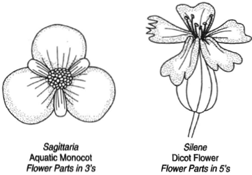 |
| Figure 35-7 Sagitaria, an aquatic monocot having flower parts in threes. Ther hizome of Sagiftaria is sometimes used as food, and the plant some times goes by the name "swamp potato." Silene, a dicot having flower parts in fives. It is sometimes called "catchfly" because, being sticky, it traps insects. It is not, however, insectivorous. |
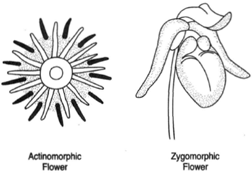 |
| Figure 35-8 An actinomorphic flower and a zygomorphic flower. |
A distinction needs to be made between a flower and an inflorescence. In some plants, the flowers are borne singly in others, they are borne in clusters. A dandelion is not a flower but, rather, aq aggregate of flowers on a single receptacle, that is, an inflorescence. Other examples of plants having inflorescences are goldenrod, daisy, and marigold. Figure 35-9 shows a hanging inflorescence called ac atkin. An inflorescence of this type occurs on willows.
When the several whorls of flower parts are inserted on the receptacle beneath the ovary and are free from the ovary, the parts are said to be hypogynous, and the ovary is said to be superior (that is, above). This is characteristic of the so-called typicalf lower. When the perianth partsg row on the summit of the ovary, the perianth parts are said to be epigynous, and the ovary is said to be inferior (that is, below). When the perianth parts are around the ovary but not at its base, the parts are said to be perigynous. Figure 35-10 illustrates these various arrangements.
The characteristics of flowers and fruits are more stable than those of leaves and are thus more relied on in taxonomic studies (in the identification and classification of plants).
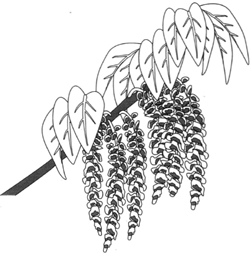 |
| Figure 35-9 Catkins, a type of inflorescence. |
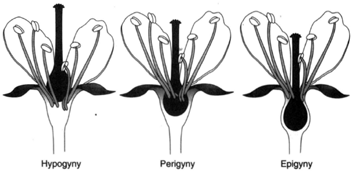 |
| Figure 35-10 The insertion of flower parts. |




